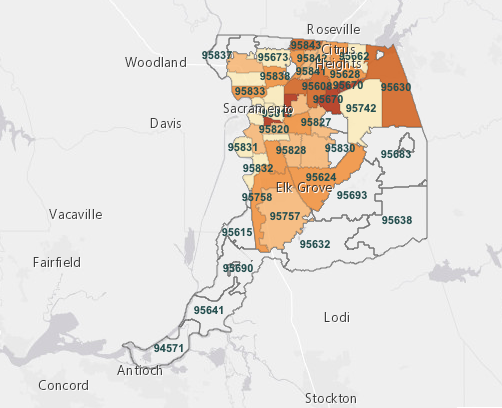
Sac County Family First Economic Support Pilot. (Photo: saccounty.net/)
A Sacramento County Welfare Program Available Only for Some Racial Groups
Does poverty discriminate on the basis of race?
By Wenyuan Wu, October 3, 2024 11:20 am
In ten days, the Sacramento County Department of Child, Family and Adult Services will close its application window for a welfare program called “Family First Economic Support Pilot (FFESP).” This guaranteed income pilot aims to provide low-income parents or legal guardians with children age 5 or younger, who live in six Sacramento zip codes, a monthly stipend of $725 for a year.
With inflation and exorbitant costs of child care, low-income parents of young children, regardless of race or ethnicity, need a break. Unfortunately, the FFESP racializes the nature of guaranteed income and turns public assistance into a pork barrel project. For parents in Sacramento to qualify for the stipend, they must show proof that they earn less than 200% of the federal poverty level and that they are caring for a child who is “Black, American Indian, or Alaska Native.” How blatantly unconstitutional!
Pegging government assistance to a selective curation of racial groups begs the big thorny question: Does poverty discriminate on the basis of race?
In 2022, the distribution of people living in poverty in the U.S. was such to include 9.5% of White Americans, 21.4% of Black, 16.7% of Hispanic, 10% of Asian/Native Hawaiian or Pacific Islander, and 24.5% of American Alaska. In California, the comparative rates were 9.1% of White Americans, 18.7% of Black, 14.8% of Hispanic, 9.5% of Asian/Native Hawaiian or Pacific Islander, and 17.1% of American Alaska. A cursory look at the proportionality numbers may lead one to infer that poverty in America correlates with race.
But the race-poverty correlation would only be true, ceteris paribus (All else being equal). The world is neither even nor random and certainly not all else being equal. To start, important demographic differences render the simple-headed comparison on race proportionality futile. Census Bureau data tells us that White Americans are on average older than racial and ethnic minorities, with the most common age being 58 vis-à-vis 11 for Hispanics, 27 for blacks and 29 for Asians. Age is a significantly more consequential factor in predicting income than race, because older individuals have had more time to work, save and accumulate wealth or assets.
Family size is another overlooked determinant that alone interferes with the race/ethnicity factor. For example, among mothers ages 40 to 44 with more than two children, 34% are White, 40% Black, 51% Hispanic and 28% Asian. Different family sizes add to statistical differences on poverty.

(Photo: saccounty.net/)
More importantly, culture matters. While adherents to cultural relativism want us to accept all cultures as equally valid and it is just a matter of perceptions, the reality stands that cultures around the world and within a country vary greatly in terms of values, norms and practices. Culture to a large extent explains why Indian Americans were the highest-earning ethnic group, followed by Filipino Americans, Taiwanese Americans and Sri Lankan Americans. To disregard cultural differences in favor of crude racial/ethnic abstractions in devising social welfare policies is tantamount to waging an ideological war on realities.
Last but not least, statistical inferences on race proportionality, presumably the rationale behind Sacramento’s FFESP program, grossly distort the full picture of poverty. In absolute numbers, there were 1,172,300 Whites, 360,800 Blacks, 2,281,200 Hispanics, 568,600 Asians and 16,000 American Indians or Alaska Natives living below the poverty line. Handing out government cash assistance to only Blacks, American Indians and Alaska Natives translates into missed opportunities for other groups that are considerably larger in numbers. It is simply unfair.
In November 1996, California made history by approving Proposition 209, a citizen-initiated ballot initiative to prohibit government preferences. The passage of Prop. 209 by over 55% of the electorate made the Golden State the first in the nation to ban discrimination and preferences on the basis of race, sex, color, ethnicity or national origin in public policies. In 2020, over 57% of a larger and more progressive electorate in the state voted to keep Prop. 209 in place by saying no to Prop. 16, a blanket repeal of the state’s constitutional guarantee of equal treatment. This year, ACA 7, another effort to circumvent Prop. 209 by way of “research-based/informed” exceptions, went down in flames as state senators were forced to contend with the sheer unpopularity of government preferences in the wake of the Supreme Court ruling against race-based affirmative action and their recent failure to pass Prop. 16.
Are Sacramento’s government bureaucrats so oblivious to the state constitution and a growing public consensus against racial preferences that they are willing to roll out a facially unconstitutional program?
If you know of a parent living in one of these zip codes in Sacramento (95815, 95821, 95823, 95825, 95828, 95838) who may miss out on the Family First Economic Support Pilot solely on the basis of race or ethnicity, would you let me know? Write me at wenyuan.wu@cferfoundation.org.
- Legal Advocacy Stops a Racially Exclusionary Scholarship at UC San Diego - October 30, 2025
- Gavin Newsom Supporter Tells Chinese American Activists to ‘Go Back to China’ - October 24, 2025
- Fighting White Supremacy Once Again, Ku Klux Klan Act is Challenging Race-based Scholarship at UCSD - August 4, 2025





Providing monthly stipends based on ethnicity and race is blatantly illegal and this needs to be challenged in the courts immediately? It’s not surprising that this is happening in Sacramento County where lawless Democrats and their unelected bureaucratic stooges are in complete control?
There is a website that provides a map and list of Sacramento County zip codes along with demographic information:
https://www.zipdatamaps.com/en/us/zip-maps/ca/city/borders/sacramento-zip-code-map
It’s interesting how this welfare program is set up in Sacramento County. Living here for a while, I’ve seen how diverse the area is, so I’m surprised that not all racial groups qualify for the same assistance. This could lead to some tension in communities that are already trying to navigate challenges like affordability and housing. Do you think this type of selective welfare program will create more divides in our neighborhoods? Or could it somehow promote targeted support? I’m curious to hear more about how people feel about this.
This is interesting—Sacramento County banning certain hemp products makes me wonder about the impact on local businesses and customers. Hemp has been such a big industry here, and I know many people who rely on these products for health and wellness. Are they mostly targeting products with high THC content, or does it extend to CBD items too? Seems like it would be helpful if the county offered more clarity on what this means for retailers and consumers. 🤔 Anyone else have thoughts on how this might affect local shops or our farmers growing hemp in the area? It’s always interesting how policies like these shape our daily lives.
“This is such an intriguing development—Sacramento County’s decision to ban certain hemp products really raises questions about its impact on local businesses and customers. 🌱 Hemp has become a major industry here, and so many people depend on these products for their health and wellness. Are they focusing primarily on high-THC items, or does this include CBD products as well? 🤔 Clear guidance from the county would definitely help retailers and consumers navigate these changes. Anyone else concerned about how this might affect our local shops or the farmers growing hemp in the area? It’s always fascinating to see how policies like these ripple through our community. 🛍️👩🌾”
The strike is certainly causing ripples, even here in Florin. It’s concerning how this impacts not just the legal system but also the residents who rely on these services. I have friends working in law offices, and they’ve mentioned the mounting stress on their teams as cases pile up. Are there any updates on negotiations? It feels like both sides need to find a resolution soon because it’s our community that’s caught in the middle. What’s the vibe in Sacramento’s legal scene right now—are folks hopeful this will end soon, or is it more uncertain?